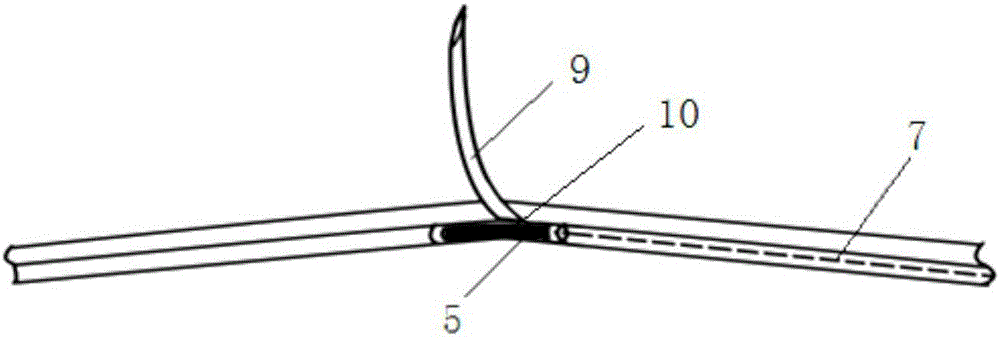Radio-frequency ablation catheter for accurately positioning lower esophageal sphincter
A precise positioning and radiofrequency ablation technology, applied in catheters, applications, muscle training equipment, etc., can solve problems such as the inability to achieve real-time, precise positioning, bending or even coiling, affecting the measurement and judgment of the real position of the LES, to improve the treatment effect, Avoid inaccurate positioning and reduce the effect of adverse reactions
- Summary
- Abstract
- Description
- Claims
- Application Information
AI Technical Summary
Problems solved by technology
Method used
Image
Examples
Embodiment 1
[0043] A radiofrequency ablation catheter for precise positioning of the lower esophageal sphincter, the structure of which is as follows figure 1As shown, it includes: a catheter handle 1 and a catheter body, the proximal end of the catheter body is connected to the catheter handle 1, and the distal end of the catheter body is sequentially provided with a catheter part 2 at the proximal end of the balloon part, a balloon part 3 and a catheter body. The catheter part 4 at the far end of the balloon part, place the solid-state pressure sensor 5 at the level of the pinholes 10 (4 channels) of the four inherent support arms of the balloon part, and connect the solid-state pressure sensor 5 and the pressure measuring host by a wire 7 8 connection, the wire 7 runs in the catheter lumen. The height of the solid-state pressure sensor is adjusted by a push-pull button 6 installed at the catheter handle 1 . When the balloon is in a collapsed state (no gas filling), after pushing the b...
Embodiment 2
[0046] On the basis of ensuring the identification of the location of the LES, in order to reduce material costs, the solid-state pressure sensor 5 in Embodiment 1 can be placed at the level of one of the needle holes 10 in the catheter (single channel), or placed in two symmetrical needle holes in the catheter The level of 10 (double passage), all the other are with embodiment 1.
Embodiment 3
[0048] In order to improve the resolution of pressure measurement, and then more accurately locate the LES, on the basis of the radiofrequency ablation catheter in Example 1, four identical support arms 11 are further symmetrically added outside the balloon, and the solid-state pressure sensor It is placed at the pinhole level of the four support arms respectively, and forms an 8-channel pressure measurement system together with the original four solid-state pressure sensors. Its structure is as image 3 shown.
PUM
 Login to View More
Login to View More Abstract
Description
Claims
Application Information
 Login to View More
Login to View More - R&D
- Intellectual Property
- Life Sciences
- Materials
- Tech Scout
- Unparalleled Data Quality
- Higher Quality Content
- 60% Fewer Hallucinations
Browse by: Latest US Patents, China's latest patents, Technical Efficacy Thesaurus, Application Domain, Technology Topic, Popular Technical Reports.
© 2025 PatSnap. All rights reserved.Legal|Privacy policy|Modern Slavery Act Transparency Statement|Sitemap|About US| Contact US: help@patsnap.com



